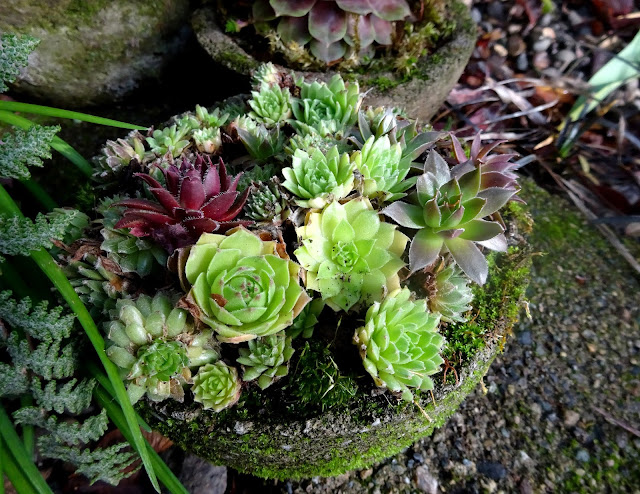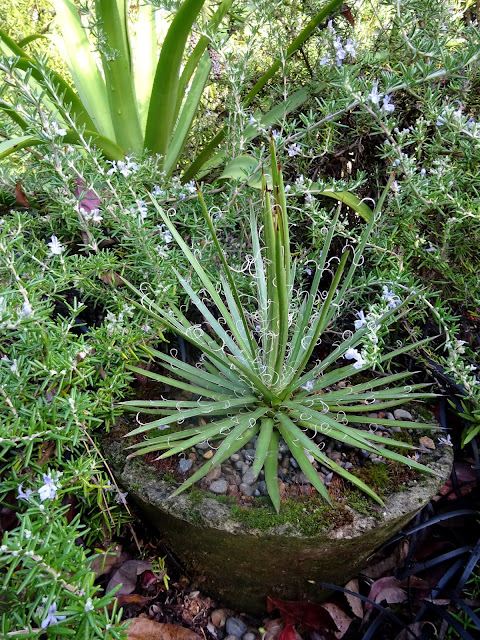The striking plant in the other pot came from Means nursery.
The first container I filled with an Agave x leopoldii, which should be able to handle what ever our winter throws at it.
Next to that is a NOID—but very ruffled—sempervivum I also picked up at Means Nursery.
Isn't it gorgeous?
I didn't set out to plant in a silver and burgundy color scheme, it just kind of unfolded that way.
I don't normally do mixed planters, but I love how this one turned out.
Another Means sempervivum, along with a few different saxifraga (one is Saxifraga 'Whitehill') and Antennaria microphylla. All bought the day I paid my final visit to Joy Creek Nursery.
The super spiky guy on the right was labeled Acantholimon laxipicatum and came to me via Ann and her trip to Kathy Allen's garden and nursery in Medford, Oregon. I hope to join her the next time she ventures that way.
This sempervivum was passed on to me from Sound Gardener, it's a special plant from our visit to Linda Boley's garden, during the 2019 Garden Bloggers Fling. Linda had a patch of these with leaves like pinecones, I asked about it and she gave a few of us plants. Unfortunately mine didn't make it, but now I get a second chance to see if those unique pinecone-like leaves will develop.
Yes there is another of the ruffled dark sempervivum, how could I buy just one?
The final pot in this set came filled with bits of different sedum, and of course moss. I was tempted to leave it as is, but added a couple plants.
(just behind the pot is the Agave parrasana 'Meat Claw', I had to share a close-up)
Anyway, the squirrels have had a great time digging in this container and making a mess of the poor plants, I keep tucking them back in.
There are a couple Saxifraga kolenatiana 'Foster's Red' mixed in there.
Along with a Monardella macrantha 'Marion Sampson'.
Okay, two container groupings down, one to go! The final group of three are to the southside of our front steps. One actually on the steps...
This one came planted with the fluffy sedum. I have not a clue what it is.
It doesn't try to compete with the moss on the planter, which let's face it, is the primary reason I love this pot.
Yes, I also had great fun taking photos and may have gotten a little carried away, the light was perfect.
Moss and agaves... it works.
Agave parrasana 'Globe' in the hypertufa cylinder, the others in the background are in the ground.
Well, except for the big guy in the metal container... (he's a NOID).
The coniferous groundcover came to me from Cistus Nursery labeled as Juniperus communis v saxatilis. The powder blue leaves on the left belong to Euphorbia ridiga.
The sedum in this last container comes from the one on the steps. I broke a few pieces off and tucked them in.
The three calluna/heather in the container were inspired by how much I've enjoyed this combination of agave and calluna nearby.
These are Calluna 'Zalina, 'Firefly' and 'Zeta'.
And with that, the hypertufa tour is done!
All material © 2009-2021 by Loree Bohl for danger garden. Unauthorized reproduction prohibited and just plain rude.













































So lush! I love everything. I should look into making a hypertufa pot or two. (I have a book that tells you how, but I've been lazy.)
ReplyDeleteI am in awe of people who make these containers, working with anything resembling cement stresses me out.
DeleteLove the hypertufa mossy goodness. The powder blue combined with burgundy and chartreuse heather is fantastic. Maybe someone can identify the "fluffy sedum".
ReplyDeleteThe patina of age (and moss) is what gave these containers their allure.
DeleteThe hypertufa containers and their look-alikes blend into your landscape perfectly. Of course, I appreciate the plants you've filled them with too. I adore Sempervivums but those I've planted in the ground haven't held up at all well; however, one a friend included in a pot with a Mangave has done far better than those in the ground so maybe I need to try more in pots.
ReplyDeleteIt makes sense that alpine plants wouldn't do well in your climate...
DeleteThose pots and the semps are gorgeous. My rock garden group makes faux hyper tufa using styrofoam boxes (used to bring in tropical fish). We carve them to give them a craggy look, paint them and then cover the paint with sand or grit. They look very authentic and weigh a fraction of what the real ones do.
ReplyDeleteI have a friend in Austin (well, she used to be in Austin) who did the same thing. So smart! Mine are small enough that they aren't heavy, thank goodness.
DeleteI did a bit of research, and I believe the cultivar name for pinecone sempervivum is Fame Montrose. Normal plants can create monstrose offsets and vice versa, so hopefully it starts performing for you. I threw some limestone chips on mine recently just in case soil pH plays some factor.
ReplyDeleteExcellent work and handy to know if I should want to buy more.
DeleteI'm amazed to see how well sempervivums do for you. With a few exceptions (like arachnoideum), sempervivums either outright perish in our Central Valley summer heat, or they fall prey to mealybugs. I'm envious!
ReplyDeleteI wish you could have attended the Denver Fling—their sempervivum were insanely cool!
DeleteI had one of those containers but never quite managed to put the right plants in it. Nothing that added to my garden the ways those all increase the beauty of yours.
ReplyDeleteI am a little worried that they are great winter additions, but won't do so well in the summer. I guess we'll see!
DeleteBeautiful pots and great plant combinations, Loree. I was struck by the one that has mostly mixed sempervivums and I thought wouldn't that be a lovely idea for a stylish wedding bouquet?
ReplyDeleteOh you're right!
DeleteSo if you and Andrew ever decide to repeat your vows someday, we know what you'll be carrying.
DeleteI love your containers of succulents and agaves! Pardon my ignorance, but what is a NOID?
ReplyDeleteNot ignorance! I think it took me awhile to figure out what it was, the first time I saw it. If I spelled it NoId, would that help? It simply means that I have no identification (no species name) on that plant.
Delete